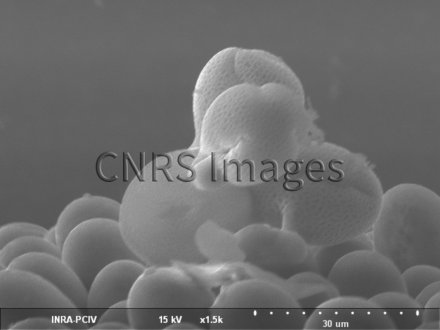Production year
2010

© Christine MEZARD / INRA / CNRS Images
20170069_0002
Initial phase of fertilisation in Arabidopsis thaliana, or mouse-ear cress, observed using a scanning microscope. A tetrad of pollen grains has been deposited onto the stigmatic papillae of a pistil. It can be seen that two of these grains are starting to germinate. Next, the pollen grains will form a pollen tube that will insert itself into the pistil to bring the sperm nucleus into contact with the ovule nucleus. Through these experiments, research scientists study meiosis, the specialised type of cell division that enables reproduction through the production of gametes. This phenomenon is accompanied by the homologous recombination of homologous chromosomes, which leads to genetic exchange or crossover, thereby producing new allele combinations in the next generation. Comparative analysis of the genomes from the four plants obtained after fertilisation by the four pollen grains in a tetrad makes it possible to reconstruct the history of homologous recombination events during a single case of meiosis.
The use of media visible on the CNRS Images Platform can be granted on request. Any reproduction or representation is forbidden without prior authorization from CNRS Images (except for resources under Creative Commons license).
No modification of an image may be made without the prior consent of CNRS Images.
No use of an image for advertising purposes or distribution to a third party may be made without the prior agreement of CNRS Images.
For more information, please consult our general conditions
2010
Our work is guided by the way scientists question the world around them and we translate their research into images to help people to understand the world better and to awaken their curiosity and wonderment.